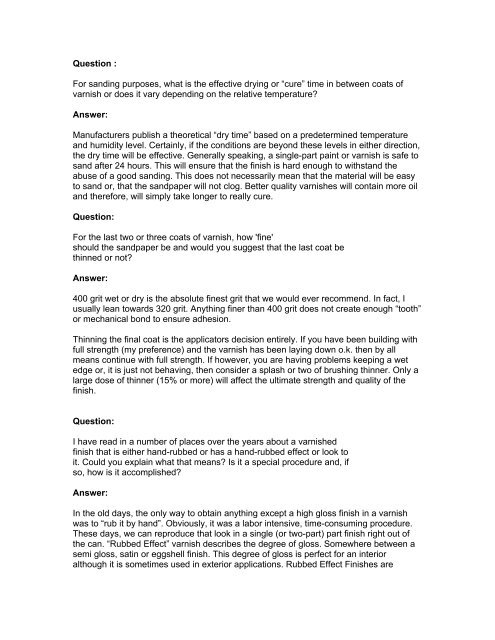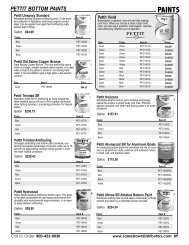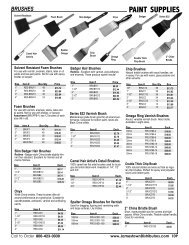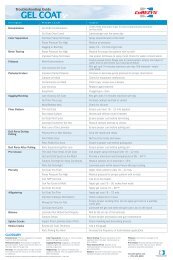technical manu al table of contents - Jamestown Distributors
technical manu al table of contents - Jamestown Distributors
technical manu al table of contents - Jamestown Distributors
Create successful ePaper yourself
Turn your PDF publications into a flip-book with our unique Google optimized e-Paper software.
Question :<br />
For sanding purposes, what is the effective drying or “cure” time in between coats <strong>of</strong><br />
varnish or does it vary depending on the relative temperature?<br />
Answer:<br />
Manufacturers publish a theoretic<strong>al</strong> “dry time” based on a predetermined temperature<br />
and humidity level. Certainly, if the conditions are beyond these levels in either direction,<br />
the dry time will be effective. Gener<strong>al</strong>ly speaking, a single-part paint or varnish is safe to<br />
sand after 24 hours. This will ensure that the finish is hard enough to withstand the<br />
abuse <strong>of</strong> a good sanding. This does not necessarily mean that the materi<strong>al</strong> will be easy<br />
to sand or, that the sandpaper will not clog. Better qu<strong>al</strong>ity varnishes will contain more oil<br />
and therefore, will simply take longer to re<strong>al</strong>ly cure.<br />
Question:<br />
For the last two or three coats <strong>of</strong> varnish, how 'fine'<br />
should the sandpaper be and would you suggest that the last coat be<br />
thinned or not?<br />
Answer:<br />
400 grit wet or dry is the absolute finest grit that we would ever recommend. In fact, I<br />
usu<strong>al</strong>ly lean towards 320 grit. Anything finer than 400 grit does not create enough “tooth”<br />
or mechanic<strong>al</strong> bond to ensure adhesion.<br />
Thinning the fin<strong>al</strong> coat is the applicators decision entirely. If you have been building with<br />
full strength (my preference) and the varnish has been laying down o.k. then by <strong>al</strong>l<br />
means continue with full strength. If however, you are having problems keeping a wet<br />
edge or, it is just not behaving, then consider a splash or two <strong>of</strong> brushing thinner. Only a<br />
large dose <strong>of</strong> thinner (15% or more) will affect the ultimate strength and qu<strong>al</strong>ity <strong>of</strong> the<br />
finish.<br />
Question:<br />
I have read in a number <strong>of</strong> places over the years about a varnished<br />
finish that is either hand-rubbed or has a hand-rubbed effect or look to<br />
it. Could you explain what that means? Is it a speci<strong>al</strong> procedure and, if<br />
so, how is it accomplished?<br />
Answer:<br />
In the old days, the only way to obtain anything except a high gloss finish in a varnish<br />
was to “rub it by hand”. Obviously, it was a labor intensive, time-consuming procedure.<br />
These days, we can reproduce that look in a single (or two-part) part finish right out <strong>of</strong><br />
the can. “Rubbed Effect” varnish describes the degree <strong>of</strong> gloss. Somewhere between a<br />
semi gloss, satin or eggshell finish. This degree <strong>of</strong> gloss is perfect for an interior<br />
<strong>al</strong>though it is sometimes used in exterior applications. Rubbed Effect Finishes are
















